UAVs and Machine Learning Revolutionising Invasive Grass and Vegetation Surveys in Remote Arid Lands
Abstract
1. Introduction
2. Materials and Methods
2.1. Process Pipeline
2.2. Site
2.3. Image Sensors
2.4. The UAV and Sample Acquisition
2.5. Software
2.6. Data Labelling
2.7. Classification Algorithm
| Algorithm 1 Detection and segmentation of invasive grasses using high-resolution RGB images. | ||
| Required: orthorectified image set I. Representative samples set G. Sample masks set H | ||
| Training | ||
| 1: | for do | ▹ total images in G (labelled data) |
| 2: | Load and images | |
| 3: | Convert colour space of into HSV | |
| 4: | Insert each colour channel into a feature array D | |
| 5: | Use 2D filters on and insert their outputs into D | |
| 6: | From and , filter only the pixels with assigned labelling on D | |
| 7: | end for | |
| 8: | Split D into training data and testing data | |
| 9: | Create a XGBoost classifier X and fit it using | |
| 10: | Use K-fold cross validation with | ▹ number of folds = 10 |
| 11: | Perform grid search to tune X parameters | |
| Prediction | ||
| 12: | for do | ▹ total images in I |
| 13: | Load image | |
| 14: | Convert colour space of into HSV | |
| 15: | Scan every pixel and predict the object using X | |
| 16: | Convert the data into a 2D image | |
| 17: | Export into TIF format | |
| 18: | end for | |
| 19: | return | |
3. Results
4. Discussion
5. Conclusions
Supplementary Materials
Supplementary File 1Acknowledgments
Author Contributions
Conflicts of Interest
Abbreviations
| 2D | Two-dimensional |
| CMOS | Complementary metal–oxide–semiconductor |
| Dry Veg. | Dry vegetation |
| GEOBIA | Geographic Object-Based Image Analysis |
| GIMP | GNU Image Manipulation Program |
| GIS | Geographic information system |
| GPS | Global positioning system |
| GSD | Ground sampling distance |
| HSV | Hue, saturation, value colour model |
| KML | Keyhole Markup Language |
| MDPI | Multidisciplinary Digital Publishing Institute |
| RAM | Random-access memory |
| RGB | Red, green, blue colour model |
| TIF | Tagged Image File |
| UAV | Unmanned Aerial Vehicles |
| WA | Western Australia |
| XGBoost | eXtreme Gradient Boosting |
References
- Godfree, R.; Firn, J.; Johnson, S.; Knerr, N.; Stol, J.; Doerr, V. Why non-native grasses pose a critical emerging threat to biodiversity conservation, habitat connectivity and agricultural production in multifunctional rural landscapes. Landsc. Ecol. 2017, 32, 1219–1242. [Google Scholar] [CrossRef]
- Schlesinger, C.; White, S.; Muldoon, S. Spatial pattern and severity of fire in areas with and without buffel grass (Cenchrus ciliaris) and effects on native vegetation in central Australia. Austral Ecol. 2013, 38, 831–840. [Google Scholar] [CrossRef]
- Fensham, R.J.; Wang, J.; Kilgour, C. The relative impacts of grazing, fire and invasion by buffel grass (Cenchrus ciliaris) on the floristic composition of a rangeland savanna ecosystem. Rangel. J. 2015, 37, 227. [Google Scholar] [CrossRef]
- Grice, A.C. The impacts of invasive plant species on the biodiversity of Australian rangelands. Rangel. J. 2006, 28, 27. [Google Scholar] [CrossRef]
- Marshall, V.; Lewis, M.; Ostendorf, B. Buffel grass (Cenchrus ciliaris) as an invader and threat to biodiversity in arid environments: A review. J. Arid Environ. 2012, 78, 1–12. [Google Scholar] [CrossRef]
- Bonney, S.; Andersen, A.; Schlesinger, C. Biodiversity impacts of an invasive grass: Ant community responses to Cenchrus ciliaris in arid Australia. Biol. Invasions 2017, 19, 57–72. [Google Scholar] [CrossRef]
- Jackson, J. Impacts and Management of Cenchrus ciliaris (buffel grass) as an Invasive Species in Northern Queensland. Ph.D. Thesis, James Cook University, Townsville, Australia, 2004. [Google Scholar]
- Jackson, J. Is there a relationship between herbaceous species richness and buffel grass (Cenchrus ciliaris)? Austral Ecol. 2005, 30, 505–517. [Google Scholar] [CrossRef]
- Martin, T.G.; Murphy, H.; Liedloff, A.; Thomas, C.; Chadès, I.; Cook, G.; Fensham, R.; McIvor, J.; van Klinken, R.D. Buffel grass and climate change: A framework for projecting invasive species distributions when data are scarce. Biol. Invasions 2015, 17, 3197–3210. [Google Scholar] [CrossRef]
- Miller, G.; Friedel, M.; Adam, P.; Chewings, V. Ecological impacts of buffel grass (Cenchrus ciliaris L.) invasion in central Australia—Does field evidence support a fire-invasion feedback? Rangel. J. 2010, 32, 353. [Google Scholar] [CrossRef]
- Smyth, A.; Friedel, M.; O’Malley, C. The influence of buffel grass (Cenchrus ciliaris) on biodiversity in an arid Australian landscape. Rangel. J. 2009, 31, 307. [Google Scholar] [CrossRef]
- Gonzalez, L.; Whitney, E.; Srinivas, K.; Periaux, J. Multidisciplinary aircraft design and optimisation using a robust evolutionary technique with variable fidelity models. In Proceedings of the 10th AIAA/ISSMO Multidisciplinary Analysis and Optimization Conference, Albany, NY, USA, 30 August–1 September 2004; pp. 3610–3624. [Google Scholar]
- Whitney, E.; Gonzalez, L.; Periaux, J.; Sefrioui, M.; Srinivas, K. A robust evolutionary technique for inverse aerodynamic design. In Proceedings of the 4th European Congress on Computational Methods in Applied Sciences and Engineering, Jyväskylä, Finland, 24–28 July 2004. [Google Scholar]
- Gonzalez, L.; Montes, G.; Puig, E.; Johnson, S.; Mengersen, K.; Gaston, K. Unmanned Aerial Vehicles (UAVs) and Artificial Intelligence Revolutionizing Wildlife Monitoring and Conservation. Sensors 2016, 16, 97. [Google Scholar] [CrossRef] [PubMed]
- Chahl, J. Unmanned Aerial Systems (UAS) Research Opportunities. Aerospace 2015, 2, 189–202. [Google Scholar] [CrossRef]
- Allison, R.S.; Johnston, J.M.; Craig, G.; Jennings, S. Airborne Optical and Thermal Remote Sensing for Wildfire Detection and Monitoring. Sensors 2016, 16, 1310. [Google Scholar] [CrossRef] [PubMed]
- Thomas, J.E.; Wood, T.A.; Gullino, M.L.; Ortu, G. Diagnostic Tools for Plant Biosecurity. In Practical Tools for Plant and Food Biosecurity: Results from a European Network of Excellence; Gullino, M.L., Stack, J.P., Fletcher, J., Mumford, J.D., Eds.; Springer International Publishing: Cham, Switzerland, 2017; pp. 209–226. [Google Scholar]
- Olsson, A.D.; van Leeuwen, W.J.; Marsh, S.E. Feasibility of Invasive Grass Detection in a Desertscrub Community Using Hyperspectral Field Measurements and Landsat TM Imagery. Remote Sens. 2011, 3, 2283–2304. [Google Scholar] [CrossRef]
- Marshall, V.M.; Lewis, M.M.; Ostendorf, B. Detecting new Buffel grass infestations in Australian arid lands: Evaluation of methods using high-resolution multispectral imagery and aerial photography. Environ. Monit. Assess. 2014, 186, 1689–1703. [Google Scholar] [CrossRef] [PubMed]
- Alexandridis, T.; Tamouridou, A.A.; Pantazi, X.E.; Lagopodi, A.; Kashefi, J.; Ovakoglou, G.; Polychronos, V.; Moshou, D. Novelty Detection Classifiers in Weed Mapping: Silybum marianum Detection on UAV Multispectral Images. Sensors 2017, 17, 2007. [Google Scholar] [CrossRef] [PubMed]
- Blaschke, T.; Hay, G.J.; Kelly, M.; Lang, S.; Hofmann, P.; Addink, E.; Queiroz Feitosa, R.; van der Meer, F.; van der Werff, H.; van Coillie, F.; Tiede, D. Geographic Object-Based Image Analysis—Towards a new paradigm. ISPRS J. Photogramm. Remote Sens. 2014, 87, 180–191. [Google Scholar] [CrossRef] [PubMed]
- Torres-Sánchez, J.; López-Granados, F.; Peña, J. An automatic object-based method for optimal thresholding in UAV images: Application for vegetation detection in herbaceous crops. Comput. Electron. Agric. 2015, 114, 43–52. [Google Scholar] [CrossRef]
- Ashourloo, D.; Aghighi, H.; Matkan, A.A.; Mobasheri, M.R.; Rad, A.M. An Investigation Into Machine Learning Regression Techniques for the Leaf Rust Disease Detection Using Hyperspectral Measurement. IEEE J. Sel. Top. Appl. Earth Obs. Remote Sens. 2016, 9, 4344–4351. [Google Scholar] [CrossRef]
- Robinson, T.; Wardell-Johnson, G.; Pracilio, G.; Brown, C.; Corner, R.; van Klinken, R. Testing the discrimination and detection limits of WorldView-2 imagery on a challenging invasive plant target. Int. J. Appl. Earth Obs. Geoinform. 2016, 44, 23–30. [Google Scholar] [CrossRef]
- Lin, F.; Zhang, D.; Huang, Y.; Wang, X.; Chen, X. Detection of Corn and Weed Species by the Combination of Spectral, Shape and Textural Features. Sustainability 2017, 9, 1335. [Google Scholar] [CrossRef]
- Schmittmann, O.; Lammers, P. A True-Color Sensor and Suitable Evaluation Algorithm for Plant Recognition. Sensors 2017, 17, 1823. [Google Scholar] [CrossRef] [PubMed]
- Bureau of Meteorology. Learmonth, WA—July 2016—Daily Weather Observations; Bureau of Meteorology: Learmonth Airport (station 005007), Australia, 2016. [Google Scholar]
- Chen, T.; Guestrin, C. XGBoost: A Scalable Tree Boosting System. In Proceedings of the 22nd ACM SIGKDD International Conference on Knowledge Discovery and Data Mining, San Francisco, CA, USA, 13–17 August 2016; ACM: New York, NY, USA, 2016; pp. 785–794. [Google Scholar]
- Pedregosa, F.; Varoquaux, G.; Gramfort, A.; Michel, V.; Thirion, B.; Grisel, O.; Blondel, M.; Prettenhofer, P.; Weiss, R.; Dubourg, V.; et al. Scikit-learn: Machine Learning in Python. J. Mach. Learn. Res. 2011, 12, 2825–2830. [Google Scholar]
- Bradski, G. The OpenCV library. Dr. Dobb’s J. Softw. Tools 2000, 25, 122–125. [Google Scholar]
- Hunter, J.D. Matplotlib: A 2D graphics environment. Comput. Sci. Eng. 2007, 9, 90–95. [Google Scholar] [CrossRef]
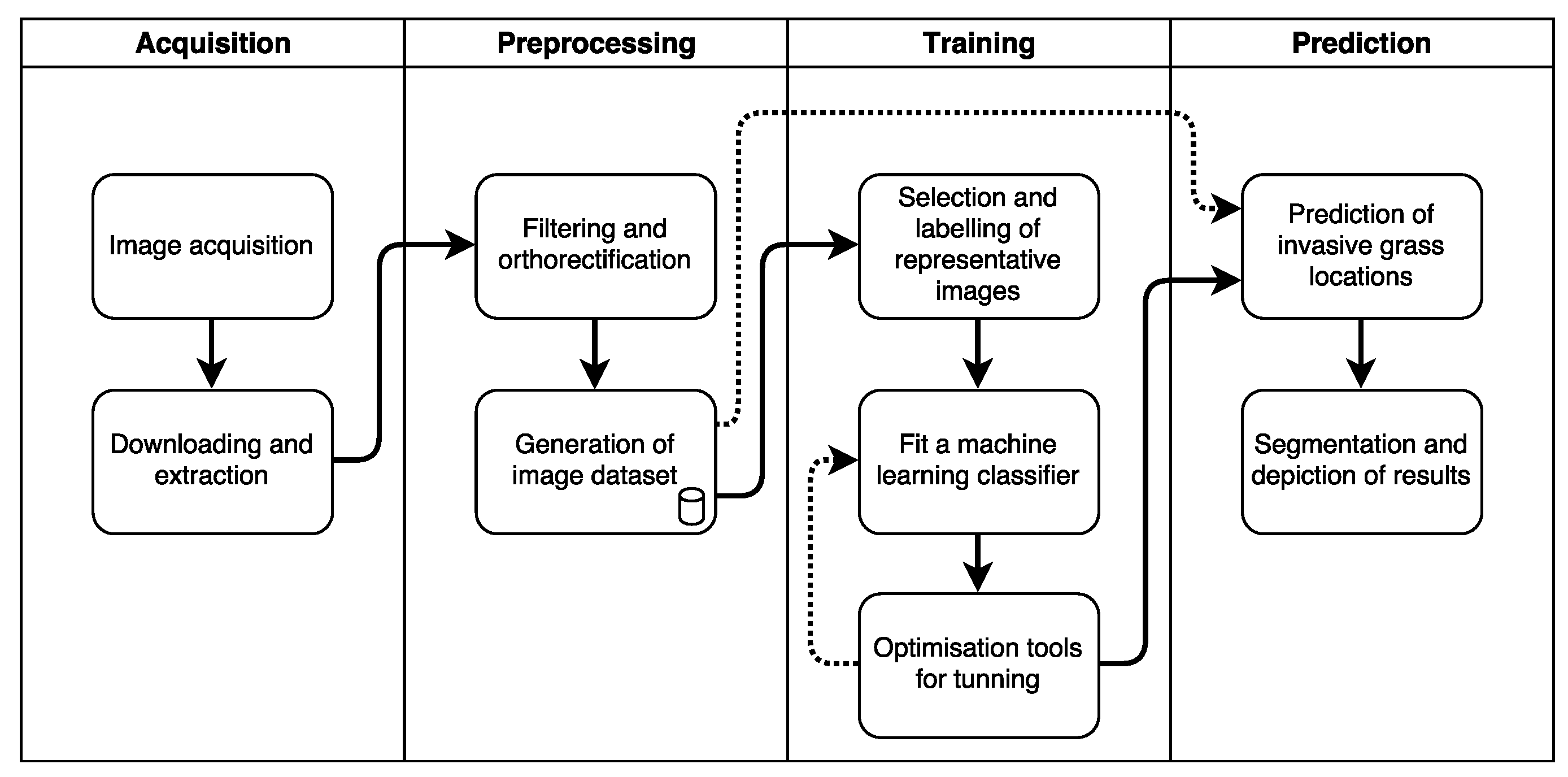
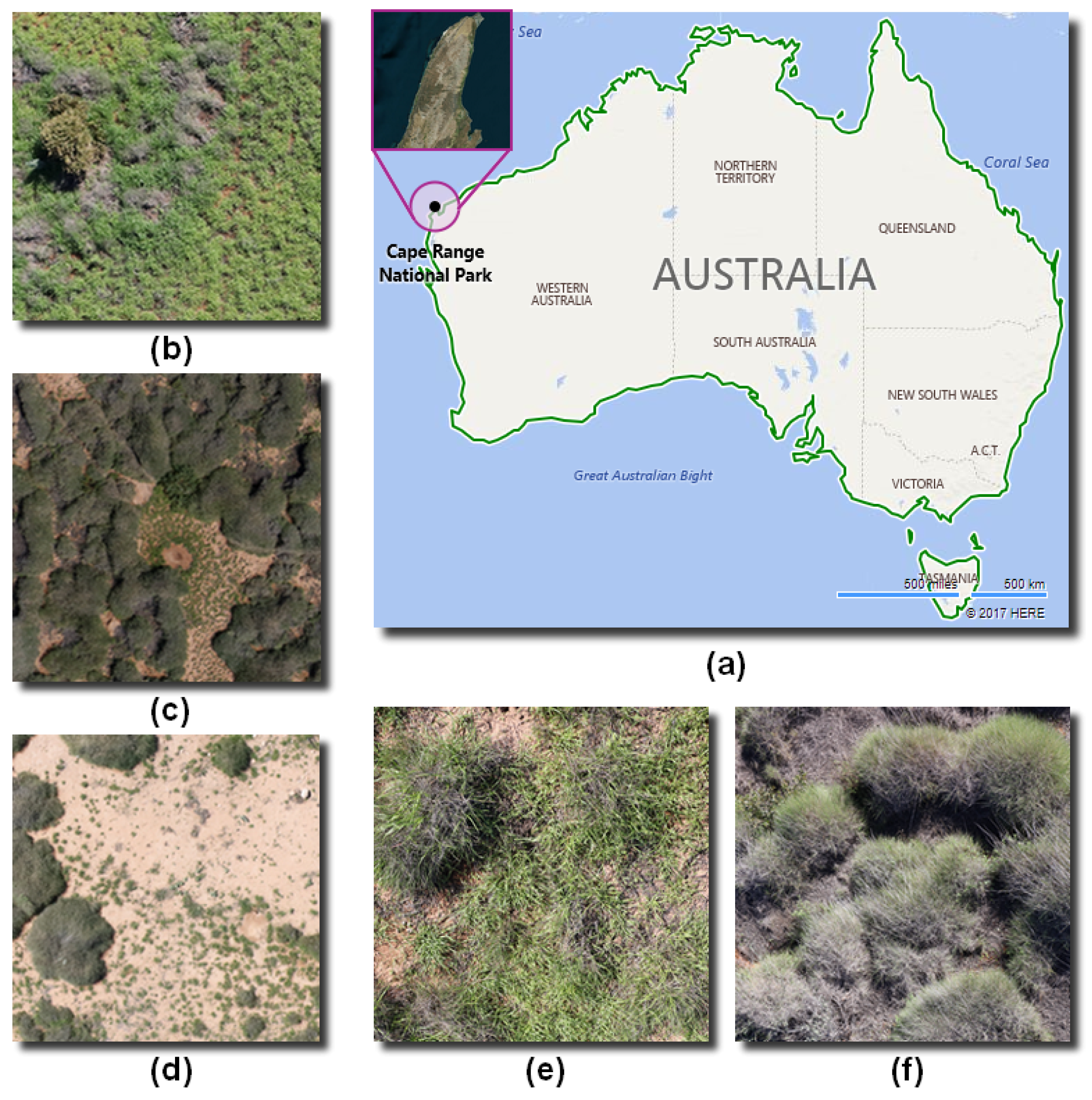

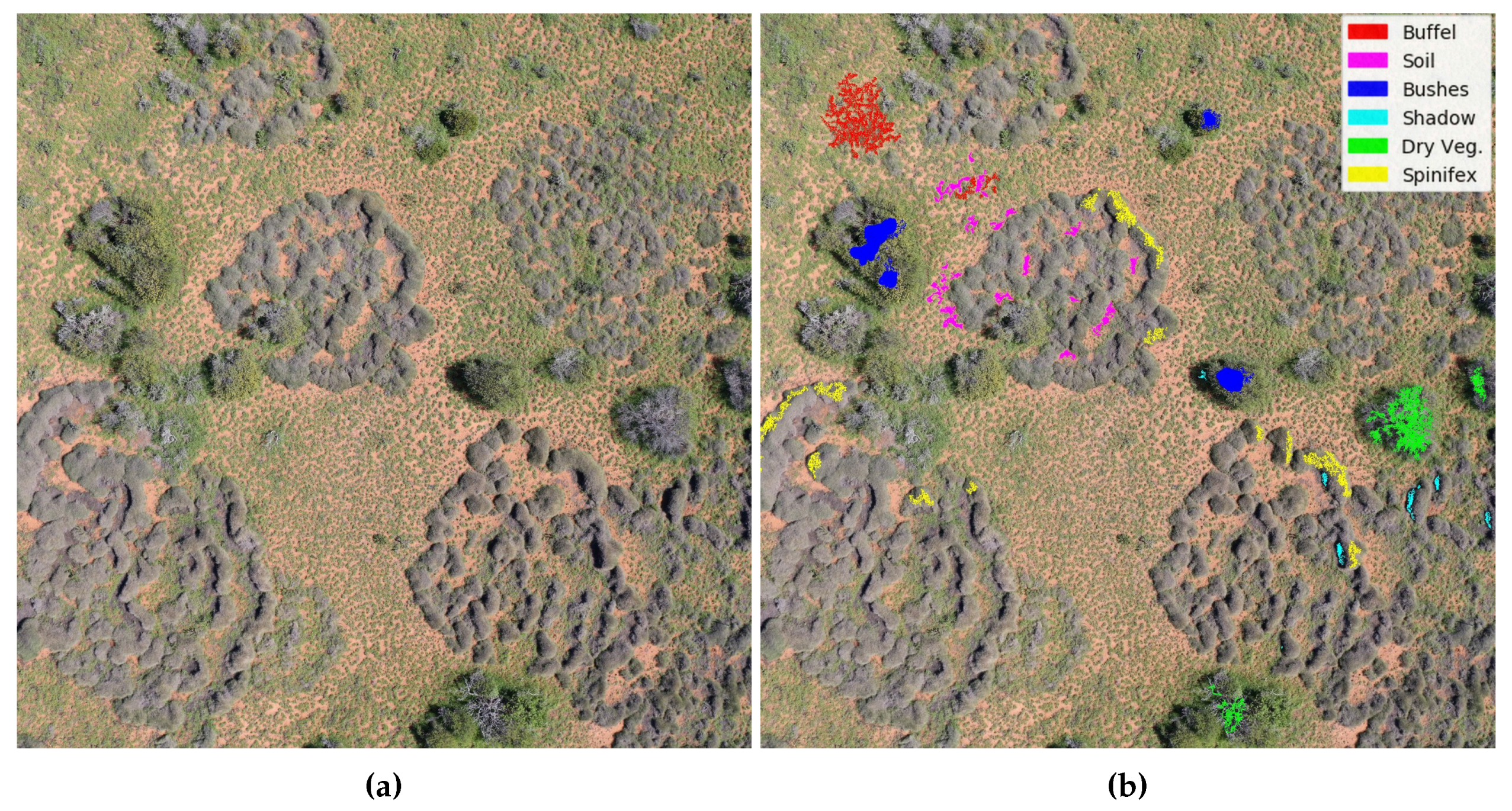
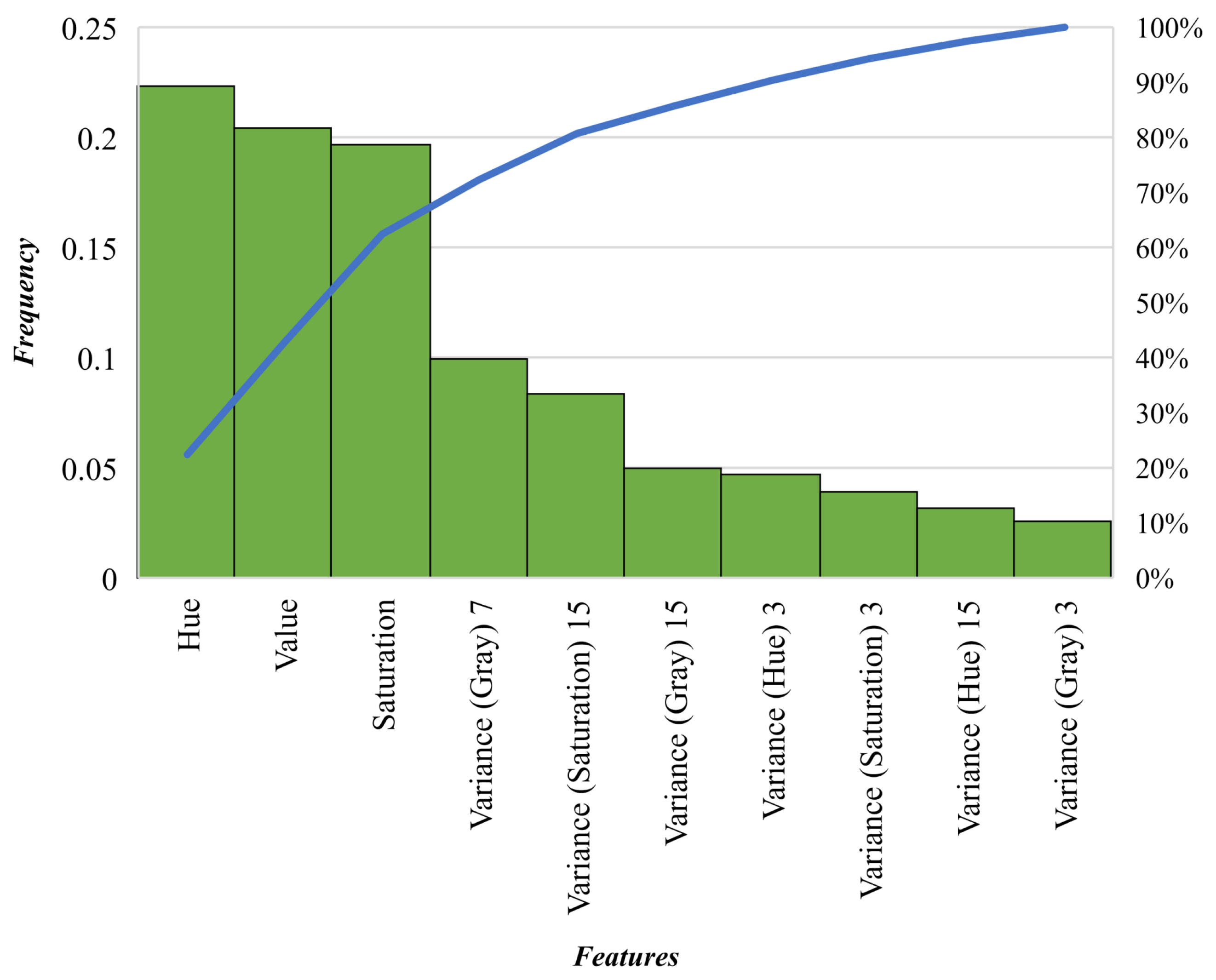
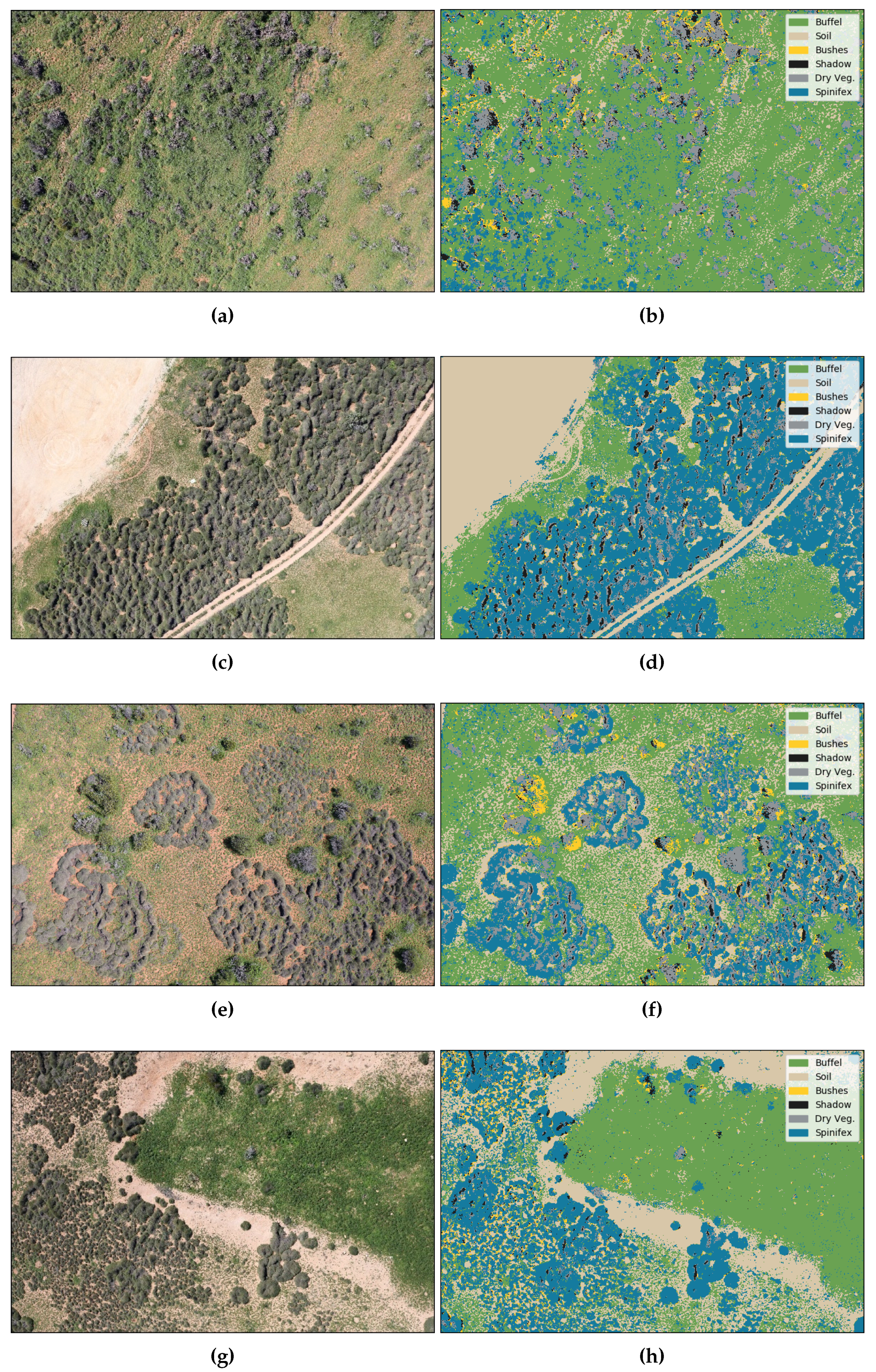

| Predicted | Buffel | Soil | Bushes | Shadow | Dry vegetation | Spinifex | |
|---|---|---|---|---|---|---|---|
| Labelled | Buffel | 25,256 | 17 | 156 | 0 | 4 | 362 |
| Soil | 15 | 25,196 | 1 | 0 | 1 | 0 | |
| Bushes | 632 | 1 | 3913 | 2 | 21 | 81 | |
| Shadow | 0 | 1 | 0 | 7729 | 0 | 0 | |
| Dry vegetation | 8 | 10 | 6 | 2 | 5734 | 159 | |
| Spinifex | 508 | 2 | 20 | 0 | 171 | 15,649 |
| Class | Precision (%) | Recall (%) | F-Score (%) | Support |
|---|---|---|---|---|
| Buffel | 95.60 | 97.91 | 96.75 | 25,795 |
| Soil | 99.88 | 99.93 | 99.90 | 25,213 |
| Bushes | 95.53 | 84.15 | 89.84 | 4650 |
| Shadow | 99.95 | 99.99 | 99.97 | 7730 |
| Dry vegetation | 96.68 | 96.87 | 96.78 | 5919 |
| Spinifex | 96.30 | 95.71 | 96.00 | 16,350 |
| Mean | 97.32 | 95.76 | 96.54 | ∑ = 85,657 |
© 2018 by the authors. Licensee MDPI, Basel, Switzerland. This article is an open access article distributed under the terms and conditions of the Creative Commons Attribution (CC BY) license (http://creativecommons.org/licenses/by/4.0/).
Share and Cite
Sandino, J.; Gonzalez, F.; Mengersen, K.; Gaston, K.J. UAVs and Machine Learning Revolutionising Invasive Grass and Vegetation Surveys in Remote Arid Lands. Sensors 2018, 18, 605. https://doi.org/10.3390/s18020605
Sandino J, Gonzalez F, Mengersen K, Gaston KJ. UAVs and Machine Learning Revolutionising Invasive Grass and Vegetation Surveys in Remote Arid Lands. Sensors. 2018; 18(2):605. https://doi.org/10.3390/s18020605
Chicago/Turabian StyleSandino, Juan, Felipe Gonzalez, Kerrie Mengersen, and Kevin J. Gaston. 2018. "UAVs and Machine Learning Revolutionising Invasive Grass and Vegetation Surveys in Remote Arid Lands" Sensors 18, no. 2: 605. https://doi.org/10.3390/s18020605
APA StyleSandino, J., Gonzalez, F., Mengersen, K., & Gaston, K. J. (2018). UAVs and Machine Learning Revolutionising Invasive Grass and Vegetation Surveys in Remote Arid Lands. Sensors, 18(2), 605. https://doi.org/10.3390/s18020605





